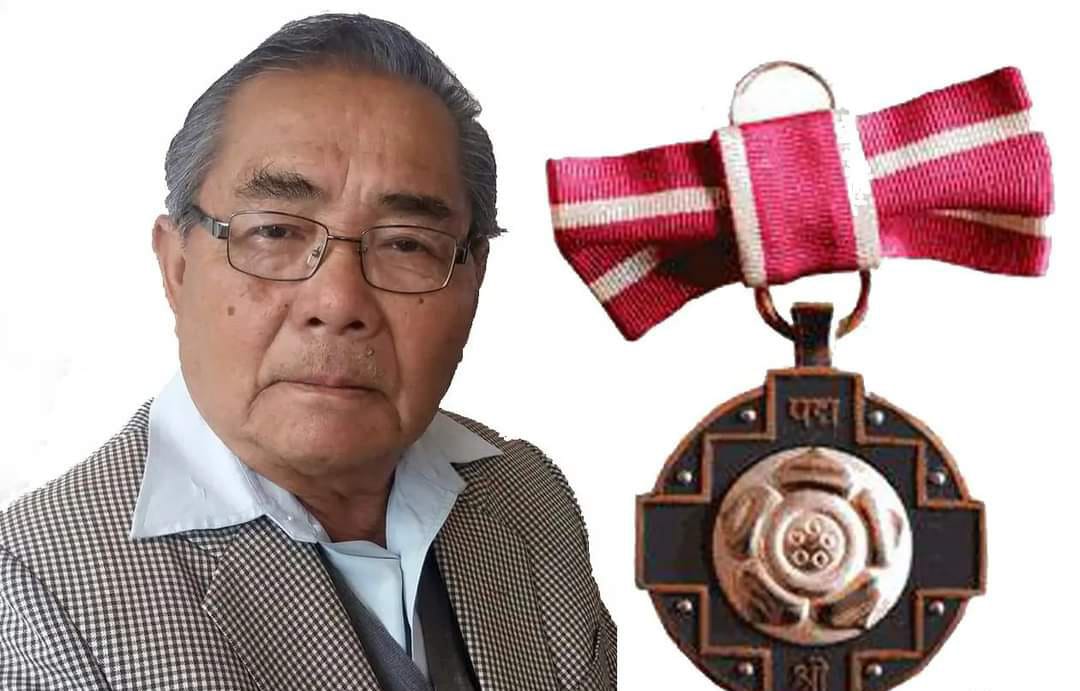SOURCE: EASTMOJO.IN
Birkha Bahadur Limboo, famously known as BB Muringla, breathed his last on June 8 at Gangtok’s STNM Hospital.
A Padma Shri recipient, Muringla was known for his contribution to Limboo language and literature. He died at the age of 80 years due to a brain haemorrhage caused by high blood pressure concerns.
Muringla is known for hand-written books from primary to secondary level, reconstructing the grammar and making easier for readers and learners of Limboo language, creating a comic series in Limboo based on the stories of Pandit Jawaharlal Nehru, Chandra Shekhar Azad and Deshbandu Chittaranjan Das.
He is also credited with writing of a Limboo-Nepali- English dictionary in two parts, designing the Limbu flag (Nissa) and Pagha. He also wrote many poems, and short stories in Nepali.
In 1982, he designed the Limboo script for letterpress with untiring efforts. In 1992, he also designed the Limboo script for computers. In 2000, the computer fonts for Limboo language was borrowed by J.R. Subba. Based on it, Karun Thapa developed “Sirijunga fonts” and his associates (J.R Subba, Y.P. Subba, Yehang Laoti and Delendra Subba) further improved the Sirijunga fonts.
He was awarded the Padma Shri by the Government of India in 2017 for his contribution to Limboo language and literature. Besides that, Muringla had received many awards and felicitation from international, national and local organizations.
Born in 1942 in Linchom, West Sikkim to father Lal Man Nugo, Muringla developed curiosity towards the Limboo language at the tender age of 10. In 1952, when he was in Class 2, he met known Limboo literary figure Iman Singh Chemjong at his residence.
The first Limboo books that he read Tum Yakthung Ningwaphu Sapla and Tum Yakthung Nisshigek Sapla influenced his curiosity towards Limboo literature. These books were collectively written by three Limboo writers – Iman Singh Chemjong, Padam Singh Muringla (Apatan) and Man Bahadur Khamdhak. Muringla’s father Lal Man Nugo was one of the financial contributors towards the publishing of these books.
Muringla’s mother was keen on having her kids to study the Limboo language, so she invited Ujjalman Subba (Mangyung), a retired Army man, to school her children. Gradually, more children from the village joined. This paved the way for the idea of the Committee School.
Muringla’s father Lal Man Nugo and Pem Dorjee Bhutia, then Mondal of the village, took it upon themselves to run the Committee School. Ujjalman Subba took charge as the teacher, Dorjee as the president and Nugo as the treasurer. The enrollment was 25 to 30 students.
Muringla studied at the Committee School till class IV then went to Tashi Namgyal Higher Secondary School in Gangtok from Class V till Class VII. The love towards Limboo language and literature stayed alive through writing letters in Limboo to his brothers and parents. Those letters became the continuation of learning the Limboo language among them.
In 1959, Muringla left for Darjeeling for further studies. In Class 11, he met Hem Chandra Pradhan, who brought a turning point in his life. Hem Chandra became a source of connection once again between Muringla and Iman Singh Chemjong. After getting Chemjong’s address, he slowly established a connection with him through exchange of letters.
On December 21, 1966, Sikkim Darbar appointed two seats in the existing Sikkim Council – one Sangha seat and one Tsong seat. Gradually, Mondal Bharandhoj Limbu (Tamling) suggested the inclusion of Limboo language in the schools of Sikkim.
He and Lal Man Nugo went to meet erstwhile Sikkim King Chogyal Palden Thondup Namgyal to request for inclusion of the language. After many visits and untiring efforts of Bharandhoj Tamling in 1968, the decision regarding the teaching of formal Limboo Language (as Tsong Language) in government schools in Sikkim was approved by the Sikkim Council.
Post Chogyal era in 1975, Muringla was appointed as manuscript writer for Limboo Language on honorarium basis. On April 24, 1976, he was appointed as manuscript writer for Limboo language in the Department of Education, Government of Sikkim. He started to study the Sirijunga script and re-fixed the number of vowels and consonants as education in Limboo was in its infancy. Within one year, he provided hand-written books from classes 1 till class 5 called Sirijunga Soksok.
The absence of technology during those days did not stop him from producing books – he made hand-written books from class 1 till class 12.
In 1979, Muringla was promoted as Text Book Officer (TBO) in the Department of Education. Professionally, he has spent his 13 years of government service as a TBO for Limboo language from primary level up to college level until he retired as Joint Director, Department of Education in 2005.

